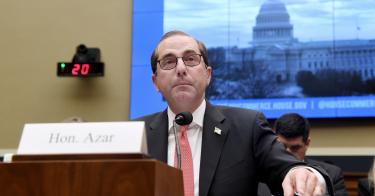Alex Azar, the new secretary of the Department of Health and Human Services, outlined an ambitious health policy agenda this week in a major address to the national meeting of the Federation of American Hospitals.
That agenda is promising, but it is far short of the major legislative changes that will be necessary to reform American health care.
The central theme of the secretary’s address was patient empowerment. He promised broad systemic changes, and warned the assembled hospital executives and other stakeholders that “change is coming,” whether they like it or not.
Specifically, Azar unveiled four major initiatives.
First was patient ownership and control of health information technology records, giving patients greater control and access over their own medical records.
“Too often, doctors and hospitals have been resistant to giving up control of records, and make patients jump through hoops to get something as basic as an image of a CT scan,” he said. “The health care consumer, not the provider, ought to be in charge of this information.”
Azar is absolutely right. In virtually all of the policy discussions on health IT, at both the federal and state levels, that many of us in the policy community have engaged in, the question that is rarely asked or answered with any clarity is this: Who actually owns the medical record? Who has a property right in the medical record? Is it property shared between the doctor and the patient? Or is it primarily the patient’s information, or the patient’s alone?
While these are the right questions, the Trump administration’s answers will, hopefully, secure the right answers.
Second, Azar declared his intention to adopt an ambitious program of price transparency.
In his address, he recounted his own experience in getting a “routine echo-cardio stress test.” When inquiring how much the test was going to cost, he said, he was told by the hospital personnel that the information wasn’t available, and persisting, found out that this routine test was listed for a stunning $5,500, with $3,500 paid for out of insurance.
Further persisting in his quest for the truth, he discovered that the test could be delivered outside of the hospital in a doctor’s office for just $550. Of course, as Azar points out, this is simply absurd, aside from being disgracefully wasteful.
The root problem is that health care “prices” are not really prices, in the conventional economic sense, reflecting the direct collision between the forces of consumer demand and provider supply in anything resembling a real market.
They are complex, negotiated payment agreements that take place within a sector of the economy, dominated by third-party, corporate, and government pricing arrangements.
Health care is an aberrant sector of the economy, where consumer control is virtually nonexistent and competition is routinely thwarted by law and regulation.
The secretary is asking medical professionals and drug companies themselves to volunteer and become “more transparent” in their pricing and their medical outcomes, but warning that, if they fail, “… we have plenty of levers to pull that would help drive this change.”
It’s not yet clear what those administrative “levers” are, and how Health and Human Services would, or could, legitimately use them to influence commercial sectors of the health care economy, rather than just Medicare, Medicaid, and the Obamacare health insurance exchanges.
Health care pricing and payment reflect radically different conditions from state to state. The secretary should be careful, therefore, not to disrupt price-transparency initiatives that are already underway in several states, such as Maryland.
Maryland, after carefully building a sophisticated database, is spotlighting price and performance for common hospital procedures for the state’s consumers.
Third, Azar reaffirmed the administration’s commitment to payment reform, using the Medicare and Medicaid programs as platforms to drive payment for “value rather than volume.”
We should pardon the public if this increasingly tiresome, overused phrase elicits a yawn, especially in light of the “lackluster” performance of Obamacare’s Accountable Care Organizations and other delivery reforms.
Azar, in effect, asks us to have faith and pledges to enlist his department’s “tremendous power to experiment with new payment models.”
Obviously, we have no idea yet what these payment models are, or how Health and Human Services will create them with its “tremendous power.” That power is narrowly administrative, and the Medicare and Medicaid systems are rigid systems of congressionally created administrative pricing.
Government is no match for markets. Markets, responding to consumer demand, are excellent in delivering value to consumers, and markets are ruthlessly efficient in controlling costs. How manipulations of administrative pricing will secure anything comparable remains unclear.
Finally, Azar promises to eliminate bureaucratic and regulatory barriers to innovation. In this connection, he cites the existing compliance and reporting burdens that are now undercutting medical professionals’ time with patients.
“Nobody benefits when our outcomes measures create burden instead of value,” he said.
Deregulation is a long-overdue and welcome development, and fully within the scope of the secretary’s vast administrative authority.
Hopefully, Azar’s promised administrative actions will prove consequential. With a new administration, they can be quickly undone. And, even if they are fully successful, they would still fall short of comprehensive health care reform.
Congress needs to take responsibility for necessary legislative action, sooner rather than later.
The first action is to provide direct relief to millions of middle-class Americans from Obamacare’s excessive federal regulation. That federal system of rigid control is discouraging anything close to meaningful competition and driving up costs in the badly damaged individual and small-group health insurance markets.
The best short-term option is to enact regulatory reforms, enabling states to expand the personal choices of their residents to affordable coverage. It is a prescription endorsed by a wide range of conservative health policy analysts.
The next congressional step is to address the underlying perverse incentives that restrict insurance portability, drive up costs, and frustrate consumer choice and competition in the health care sector of the economy.
That means finally fixing the broken federal tax treatment of health insuranceand providing Americans individual tax relief for the purchase of the health insurance of their choice.
To empower consumers, Washington must empower consumers. That means, in short, giving them direct control over their health care dollars and decisions.
In and of themselves, short-term administrative or regulatory initiatives can never accomplish that ultimate goal.
This piece originally appeared in The Daily Signal





